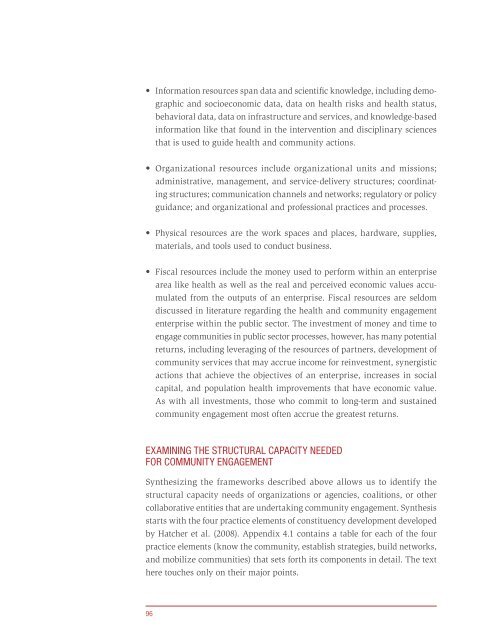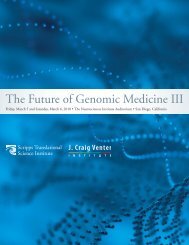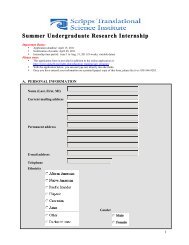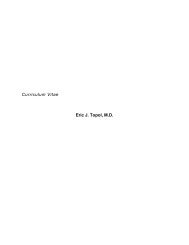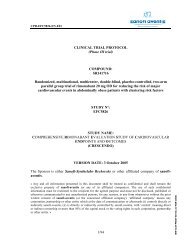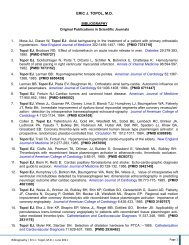• In<strong>for</strong>mation resources span data and scientific knowledge, including demographicand socioeconomic data, data on health risks and health status,behavioral data, data on infrastructure and services, and knowledge-basedin<strong>for</strong>mation like that found in the intervention and disciplinary sciencesthat is used to guide health and community actions.• Organizational resources include organizational units and missions;administrative, management, and service-delivery structures; coordinatingstructures; communication channels and networks; regulatory or policyguidance; and organizational and pr<strong>of</strong>essional practices and processes.• Physical resources are the work spaces and places, hardware, supplies,materials, and tools used to conduct business.• Fiscal resources include the money used to per<strong>for</strong>m within an enterprisearea like health as well as the real and perceived economic values accumulatedfrom the outputs <strong>of</strong> an enterprise. Fiscal resources are seldomdiscussed in literature regarding the health and community engagemententerprise within the public sector. The investment <strong>of</strong> money and time toengage communities in public sector processes, however, has many potentialreturns, including leveraging <strong>of</strong> the resources <strong>of</strong> partners, development <strong>of</strong>community services that may accrue income <strong>for</strong> reinvestment, synergisticactions that achieve the objectives <strong>of</strong> an enterprise, increases in socialcapital, and population health improvements that have economic value.As with all investments, those who commit to long-term and sustainedcommunity engagement most <strong>of</strong>ten accrue the greatest returns.EXAMINING THE STRUCTURAL CAPACITY NEEDEDFOR COMMUNITY ENGAGEMENTSynthesizing the frameworks described above allows us to identify thestructural capacity needs <strong>of</strong> organizations or agencies, coalitions, or othercollaborative entities that are undertaking community engagement. Synthesisstarts with the four practice elements <strong>of</strong> constituency development developedby Hatcher et al. (2008). Appendix 4.1 contains a table <strong>for</strong> each <strong>of</strong> the fourpractice elements (know the community, establish strategies, build networks,and mobilize communities) that sets <strong>for</strong>th its components in detail. The texthere touches only on their major points.96
Practice Element 1: Know the <strong>Community</strong>The first practice element is focused on knowing the community’s history andexperience, its constituents, and their capabilities. In a sense, this practiceelement addresses the intelligence-gathering function behind planning, decisionmaking, and leveraging resources to collaboratively achieve anticipatedor agreed-upon outcomes with community partners. As depicted in Table4.1, this element speaks to the need <strong>for</strong> a wide range <strong>of</strong> data types, securereporting and collection systems, human skills and equipment to analyzeand interpret data, organizational processes to communicate this in<strong>for</strong>mationand foster its use in decision making, and a culture that values communityengagedin<strong>for</strong>mation gathering and use. The goal is to enable all partners tounderstand diverse viewpoints on community issues and to appreciate therange <strong>of</strong> solutions that may address those issues.The individuals and groups from communities or organizations undertakingengagement activities have differing abilities to assimilate data through theirrespective filters. If understanding is not developed collectively,it is <strong>of</strong>ten difficult to move to a collective decision or action. Allbut the smallest homogenous communities have multiple layers<strong>of</strong> complexity that require organized, collective ways to obtainand understand community in<strong>for</strong>mation. In brief, understandingis rooted in experience, social and cultural perspectives, perceptions<strong>of</strong> influence, and the ability to act collaboratively within theengaging organization and the engaged community. Thus, the task<strong>of</strong> knowing a community must be approached as an organizational functionand supported with sufficient capacity to collectively undertake this work.If understanding is notdeveloped collectively, it is <strong>of</strong>tendifficult to move to a collectivedecision or action.Practice Element 2: Establish Positions and StrategiesTo successfully address Practice Element 2, structural capacity must be in placeto identify the engaging organization’s priorities regarding community healthissues as well as any limitations in the organization’s mission, funding, orpolitics that will restrain its ability to address those issues. The development<strong>of</strong> positions and strategies allows an organization to effectively plan its rolein the community engagement process. In particular, it is critical to be clearabout the organization’s intentions and its ability to adjust and align its positionto differing viewpoints and priorities likely to exist within the community.An introspective review will examine whether the organization is willing to97
- Page 1:
PRINCIPLES OFCOMMUNITY ENGAGEMENTSE
- Page 6 and 7:
PUBLICATION DEVELOPMENTThis publica
- Page 8 and 9:
Foreword
- Page 10 and 11:
detailed practical information abou
- Page 12 and 13:
EXECUTIVE SUMMARYInvolving the comm
- Page 15 and 16:
REFERENCESAhmed SM, Palermo AG Comm
- Page 19:
clinics, agencies, after-school pro
- Page 23 and 24:
2 Design and delivery—Improvement
- Page 25 and 26:
There is no question that culture a
- Page 27 and 28:
oot causes of problems while at the
- Page 29 and 30:
• Know the community, its constit
- Page 31 and 32:
• Coalitions require that each pa
- Page 34 and 35:
2006; Wing, 2002) There is also unc
- Page 38 and 39:
and stakeholders are represented eq
- Page 40 and 41:
ContextsSocioeconomic, Cultural,Geo
- Page 44 and 45:
REFERENCESAirhihenbuwa CO Health an
- Page 47 and 48:
Flicker S, Travers R, Guta A, McDon
- Page 49 and 50:
Jones MR, Horner RD, Edwards LJ, Ho
- Page 51 and 52:
Minkler M Community organizing and
- Page 53 and 54: Shore N Community-based participato
- Page 55: Yale Center for Clinical Investigat
- Page 58 and 59: successful Each principle covers a
- Page 60 and 61: cultural environment and its intera
- Page 62 and 63: is of the community when it is cont
- Page 64 and 65: the “trigger” for the engagemen
- Page 66 and 67: Successful Examples in the Field
- Page 68 and 69: 3 Project SuGAR4 The Community Heal
- Page 70 and 71: 1. COMMUNITY ACTION FOR CHILD HEALT
- Page 72 and 73: including the collection of biospec
- Page 74 and 75: Applications of Principles of Commu
- Page 77 and 78: Websiteshttp://academicdepartmentsm
- Page 79 and 80: of the community context, developme
- Page 81 and 82: 5. HEALING OF THE CANOEBackground:
- Page 83 and 84: 6. FORMANDO NUESTRO FUTURO/SHAPING
- Page 85 and 86: 7. IMPROVING AMERICAN INDIAN CANCER
- Page 87 and 88: and the mistreatment of some Americ
- Page 90 and 91: Applications of Principles of Commu
- Page 92 and 93: Applications of Principles of Commu
- Page 94 and 95: Applications of Principles of Commu
- Page 96 and 97: The success of the initialprogram h
- Page 98 and 99: 12. DETERMINANTS OF BRUSHING YOUNG
- Page 100 and 101: Managing Organizational Supportfor
- Page 102: al., 2009), and (3) the constituenc
- Page 107 and 108: each capacity component for this pr
- Page 109 and 110: REFERENCESButterfoss FD. Coalitions
- Page 111 and 112: Table 4.1. Know the Community, Its
- Page 113: Table 4.3. Build and Sustain Networ
- Page 116 and 117: Chapter 5Challenges in Improving Co
- Page 118 and 119: 1. ENGAGING AND MAINTAINING COMMUNI
- Page 120 and 121: • Collaboratively developing an M
- Page 122 and 123: • Employ a variety of participati
- Page 124 and 125: ChallengeThe John Avery Boys and Gi
- Page 126 and 127: 2. OVERCOMING DIFFERENCES BETWEEN A
- Page 128 and 129: the West Virginia PRC, the North Ca
- Page 130 and 131: Action StepsThe university partners
- Page 132 and 133: C. How do you engage a community wh
- Page 134 and 135: As seats came open on the CAB, memb
- Page 136 and 137: ought a communication from the cont
- Page 138 and 139: and research leadership Partners al
- Page 140 and 141: ReferencesDino G, Horn K, Abdulkadr
- Page 142: Action StepsMorehouse continued to
- Page 145 and 146: ReferencesBlumenthal DS A community
- Page 147 and 148: parties grew frustrated The partner
- Page 149 and 150: 5. OVERCOMING COMPETING PRIORITIES
- Page 151 and 152: ReferenceReifsnider E, Hargraves M,
- Page 153 and 154:
Take-Home Messages• “Splitting
- Page 155 and 156:
Although the CTSA sites in the Bost
- Page 157 and 158:
Chapter 6The Value of Social Networ
- Page 159 and 160:
Social networks can also play an im
- Page 161 and 162:
engagement effort, relationships mu
- Page 163 and 164:
engagement Furthermore, social medi
- Page 165 and 166:
REFERENCESArthur T The role of soci
- Page 167 and 168:
Program Evaluation and EvaluatingCo
- Page 169 and 170:
approaches to evaluation that are p
- Page 171 and 172:
Several institutions have identifie
- Page 173 and 174:
PlanningThe relevant questions duri
- Page 175 and 176:
was evaluated (Anderson et al, 2009
- Page 177 and 178:
• Participants meet to communicat
- Page 179 and 180:
Table 7.1. Types of Evaluation Ques
- Page 181 and 182:
conducted with a loose set of quest
- Page 183 and 184:
for understanding a community and i
- Page 185 and 186:
REFERENCESAnderson RM, Funnell MM,
- Page 187 and 188:
Patton MQ Qualitative evaluation an
- Page 189 and 190:
Chapter 8SummaryDonna Jo McCloskey,
- Page 191 and 192:
• Know the extent to which the fo
- Page 193 and 194:
Appendix A:Acronyms
- Page 195 and 196:
CDCCenters for Disease Control and
- Page 197:
NIH Publication No. 11-7782


